Photos with this report (click to enlarge) | |||
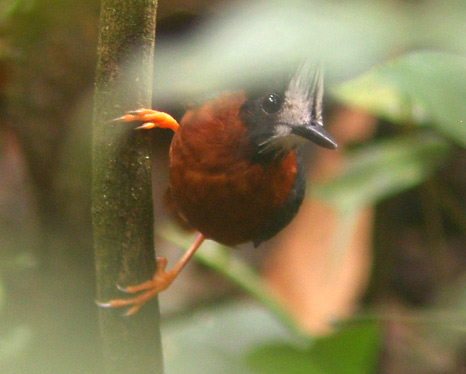 White-plumed Antbird |
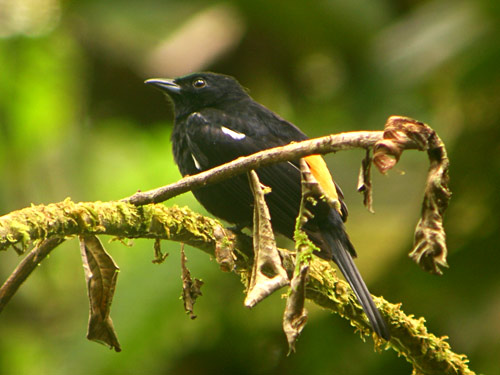 Fulvous-crested Tanager |
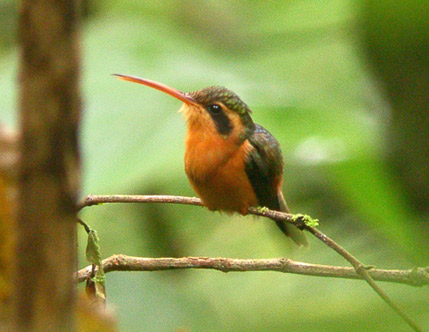 Reddish Hermit |
|
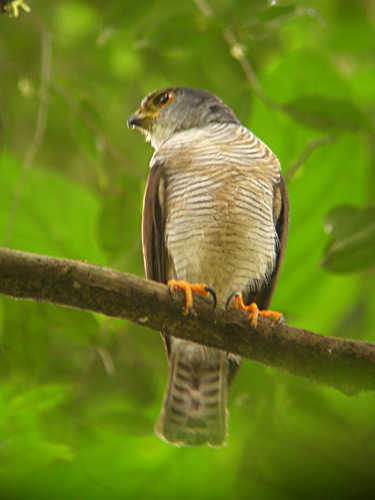 Tiny Hawk |
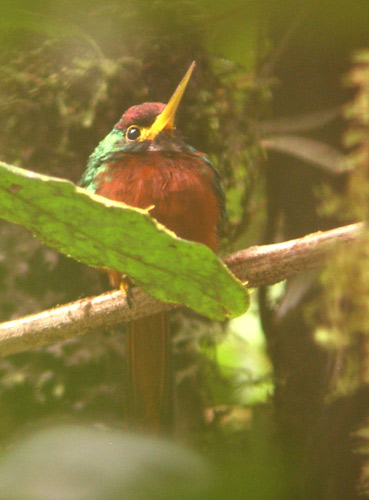 Yellow-billed Jacamar |
||
Introduction
Shiripuno Lodge is a new lodge in the Ecuadorian Amazon, located in pristine forest within the Huaorani Anthropological Reserve. It is in a remote area, and hunting and logging has been kept to a minimum, so all the big indicator species like curassows and eagles are still present. Habitat is mainly primary terra firme forest, but there are swamps, small oxbow lakes, riverside scrub, and some low hills. Várzea forest is lacking. The area is still not very well known, and we had the feeling that there are still plenty of great birds waiting to be found here.
The lodge is co-owned and co-managed by Jarol Fernando Vaca, a naturalist and bird guide with extensive experience at most of the Amazon lodges in Ecuador. Jarol decided to offer a week-long “bird count” at his lodge in order to increase exposure, find more birds for the list, and see just how many birds could be recorded in a moderate-length stay. He invited many of the guides and ornithologists in Ecuador, but most could not come due to prior commitments. In the end, there were only three of us: the Tropical Birding contingent as well as Vinicio Perez of Mindo fame. A few had bailed out at the last minute; too bad for them! The birding was phenomenal, at least as good as anywhere else we have ever birded in the Amazon.
Logistics
Access is from the city of Coca, where there are numerous daily flights from Quito with several different airlines. From Coca it was about a three hour drive south on a very rough road to the Shiripuno River. Here we boarded a motorized canoe, and headed downstream along the narrow and sinuous river for about 3h15m to the lodge. This trip can take longer when the river is lower, and the return journey took at least a half-hour longer since we were going against the current.
Climate
There was quite a lot of rain for the first half of our visit, with drizzle in the mornings and solid downpours in the afternoon. This resulted in very muddy trails (rubber boots are a necessity here). On the last few days, there was very little rain, but it was mostly cloudy and surprisingly cool. Temperatures varied from roughly 72ºF(23ºC) to 85ºF(30ºC).
The Lodge
The lodge is located in a small clearing on the edge of the river. It is simple, but we would not call it basic. “Basic” usually implies unpleasant, but that certainly is not the case for Shiripuno. There are eight rooms with one to three beds in each room, and private bathrooms with cold-water showers. Rooms are open and airy, and though biting insects were never a problem, mosquito nets are provided. Beds are comfortable, and we both slept very well here. It could get quite cool at night, considering the lodge is at 220 meters elevation. You should bring your own towel and soap.
There is no electricity here, and light is provided by candle. There is a generator, but they only use it upon request when it is necessary to charge batteries. The lack of generator noise made it wonderfully quiet compared to some other Amazon lodges we have stayed it. The regular night sounds around the lodge (Tawny-bellied Screech-Owl, Great Potoo, Night Monkeys, Nocturnal Curassow, etc) were a perfect bedtime lullaby for those of us who love the Amazon.
Food was not fancy, but it was quite good. Breakfasts were large, which was appreciated with the long hours we put in. Box lunches were frequently delivered to us on the trail by lodge staff, still warm. Dinners always came with a soup, main course, and a dessert.
Booking enquiries should be directed to ofshiripuno2004@yahoo.com. Jarol is sometimes available to guide groups. If not, and unless you are experienced in Amazonian birding, you might want to book it though a local agency such as Tropical Birding, who could provide you with a professional guide.
Birding
One word: FLOCKS! The mixed species flocks we encountered here blew away anything we have ever seen anywhere in the Amazon, ever. They were truly mind-blowing, and frequently came one right on top of the other, to the point where it was often difficult to make any significant progress on the trail we were birding. Activity regularly continued well into the afternoon, making the forest interior birding here much more exciting than in most other Amazon lodges. This kind of birding is some of the hardest in the world, and we benefited from the sheer number of flocks by having multiple chances to track down some of the less common species. In this way we eventually we achieved good looks at some species that we first saw poorly. There is currently no canopy tower, though Jarol hopes to be able to build one by the end of 2007. Considering the flock activity, a tower here could be fantastic.
Apart from the flocks, there were still other great birds to be found. We saw three antpittas, five jacamars, some nice manakins and cotingas, and numerous parrots. One morning we saw at least 25 Blue-and-yellow Macaws! There is a parrot lick, but it is at least a 3km hike to get there, and you have to be there fairly early to see any activity. We arrived at 2pm and were too late because we had seen so much along the way. On one day alone we saw and/or heard over 30 spp. of antbirds.
We encountered several small antswarms, though we suspect the swarms might be better in drier periods. White-plumed Antbirds were the most common attendants, but we also saw Hairy-crested Antbird, Bicolored Antbird, Sooty Antbird, and heard Reddish-winged Bare-eye.
There isn’t any significant seasonally flooded várzea forest near the lodge, so some of the várzea specialists are rare or absent. The river is also so small that it doesn’t support river island specialists or the common river birds like terns and some of the herons. However the terra firme was so good that it made up for it. This would be a great lodge to combine with one of the other lodges along the Napo River with good várzea, such as Sacha or Sani.
Some notable species:
Nocturnal Curassow – We heard them most nights from the lodge, and there were clearly several in the area. One night we walked perhaps 500m into the forest, following our ears, and after at least a half hour of effort we managed find a small gap in the canopy over a stream and spotlighted a singing bird perched at least 30m up in the top of an emergent tree!
Salvin’s Curassow – We only heard it once, and though we got very close to it, we failed to see it. Jarol has seen them quite regularly here.
Black-throated Hermit – They were fairly common on the Misterioso Trail, and we saw several on our day spent there. This is a species with a fairly restricted range, which doesn’t seem to be common anywhere.
Fiery Topaz – One of the star birds of Shiripuno. We found two males and a female. The males were mainly coming to feed on a flowering canopy epiphyte in the Marcgraviaceae family, which according to Jarol are their favorite food source.
Spotted Puffbird – A rare bird in Ecuador, they are regularly seen on the trail system behind the lodge. We saw one and heard another.
Great Jacamar – Widespread but usually found at low densities, here this species seems especially common and we saw three birds on three different trails and heard another.
Yasuní Antwren – Shiripuno just might be the best place to see this local species. We found them to be fairly common in the mixed understory flocks led by Cinereous and Dusky-throated Antshrikes.
Rio Suno Antwren – Another rare antwren that we found to be fairly common with mixed understory flocks.
Wing-banded Antbird – We found two pairs of this rare and local oddity, and Jarol knows at least one other territory for it.
White-lored Antpitta – We heard them several times along the river, and finally saw one, with much effort, on the Laguna Trail next to a small oxbow lake.
Ochre-striped Antpitta – Fairly common throughout the area, but notoriously difficult to see. We finally got great looks after about an hour’s worth of trying.
Ash-throated Gnateater – A Western Amazon specialty that we saw very well on the Colibrí Trail behind the lodge. The Napo River forms the northern limit of this species’ range.
Citron-bellied Attila – One of the first birds we saw in the forest behind the lodge; much of this species’ range is rather inaccessible.
Black-necked Red-Cotinga – We saw one female late one afternoon on the Saladero Trail. So far no one has found a lek, but there must be one around.
Short-billed Honeycreeper – We found this Ecuador rarity feeding in a fruiting Clusia with other tanagers.
Casqued Oropendola – Another Western Amazon specialty, we found a few individuals mixed in with the hordes of Russet-backed and Crested Oropendolas.
List follows The Birds of Ecuador, Robert S. Ridgely and Paul J. Greenfield, 2001
Seen: 275
Heard only: 57
Total: 332
C=Only in Coca
H=Heard Only
TINAMIDAE - TINAMOUS
H-Great Tinamou (Tinamus major)
H-White-throated Tinamou (Tinamus guttatus)
H-Cinereous Tinamou (Crypturellus cinereus)
H-Little Tinamou (Crypturellus soui)
H-Undulated Tinamou (Crypturellus undulatus)
H-Variegated Tinamou (Crypturellus variegatus)
H-Bartlett's Tinamou (Crypturellus bartletti)
ARDEIDAE - HERONS, BITTERNS, EGRETS
H-Rufescent Tiger-Heron (Tigrisoma lineatum)
C-Great Egret (Ardea alba)
C-Snowy Egret (Egretta thula)
Striated Heron (Butorides striatus)
CATHARTIDAE - AMERICAN VULTURES
King Vulture (Sarcoramphus papa)
Black Vulture (Coragyps atratus)
Greater Yellow-headed Vulture (Cathartes melambrotus)
ACCIPITRIDAE - KITES, EAGLES, HAWKS
Gray-headed Kite (Leptodon cayanensis)
Hook-billed Kite (Chondrohierax uncinatus)
Swallow-tailed Kite (Elanoides forficatus)
Double-toothed Kite (Harpagus bidentatus)
Plumbeous Kite (Ictinia plumbea)
Tiny Hawk (Accipiter superciliosus)
Black-faced Hawk (Leucopternis melanops)
Great Black-Hawk (Buteogallus urubitinga)
Roadside Hawk (Buteo magnirostris)
Black Hawk-Eagle (Spizaetus tyrannus)
Ornate Hawk-Eagle (Spizaetus ornatus)
FALCONIDAE - FALCONS AND CARACARAS
Black Caracara (Daptrius ater)
H-Red-throated Caracara (Ibycter americanus)
Laughing Falcon (Herpetotheres cachinnans)
Bat Falcon (Falco rufigularis)
CRACIDAE - CURASSOWS, GUANS, ETC.
Speckled Chachalaca (Ortalis guttata)
Spix's Guan (Penelope jacquacu)
Common Piping-Guan (Pipile pipile)
Nocturnal Curassow (Nothocrax urumutum)
H-Salvin's Curassow (Mitu salvini)
ODONTOPHORIDAE - NEW WORLD QUAILS
H-Marbled Wood-Quail (Odontophorus gujanensis)
RALLIDAE - RAILS, GALLINULES, ETC.
H-Rufous-sided Crake (Laterallus melanophaius)
H-Black-banded Crake (Laterallus fasciatus)
H-Chestnut-headed Crake (Anurolimnas castaneiceps)
Gray-necked Wood-Rail (Aramides cajanea)
Purple Gallinule (Porphyrula martinica)
PSOPHIIDAE - TRUMPETERS
H-Gray-winged Trumpeter (Psophia crepitans)
SCOLOPACIDAE - SANDPIPERS, SNIPES, ETC.
Spotted Sandpiper (Actitis macularia)
LARIDAE - GULLS AND TERNS
Laughing Gull (Larus atricilla)
COLUMBIDAE - PIGEONS AND DOVES
C-Rock Pigeon (Columba livia)
C-Pale-vented Pigeon (Columba cayennensis)
Ruddy Pigeon (Columba subvinacea)
Plumbeous Pigeon (Columba plumbea)
Ruddy Ground-Dove (Columbina talpacoti)
Blue Ground-Dove (Claravis pretiosa)
Gray-fronted Dove (Leptotila rufaxilla)
PSITTACIDAE - PARROTS AND MACAWS
Blue-and-yellow Macaw (Ara ararauna)
Scarlet Macaw (Ara macao)
Chestnut-fronted Macaw (Ara severa)
Red-bellied Macaw (Orthopsittaca manilata)
White-eyed Parakeet (Aratinga leucophthalmus)
Dusky-headed Parakeet (Aratinga weddellii)
Maroon-tailed Parakeet (Pyrrhura melanura)
Cobalt-winged Parakeet (Brotogeris cyanoptera)
Black-headed Parrot (Pionites melanocephala)
Orange-cheeked Parrot (Pionopsitta barrabandi)
Blue-headed Parrot (Pionus menstruus)
Yellow-crowned Amazon (Amazona ochrocephala)
Orange-winged Amazon (Amazona amazonica)
Mealy Amazon (Amazona farinosa)
CUCULIDAE - CUCKOOS AND ANIS
Squirrel Cuckoo (Piaya cayana)
Smooth-billed Ani (Crotophaga ani)
STRIGIDAE - TYPICAL OWLS
H-Tropical Screech-Owl (Otus choliba)
H-Tawny-bellied Screech-Owl (Otus watsonii)
Ferruginous Pygmy-Owl (Glaucidium brasilianum)
Crested Owl (Lophostrix cristata)
NYCTIBIIDAE - POTOOS
Great Potoo (Nyctibius grandis)
Common Potoo (Nyctibius griseus)
CAPRIMULGIDAE - NIGHTJARS & NIGHTHAWKS
Short-tailed Nighthawk (Lurocalis semitorquatus)
Pauraque (Nyctidromus albicollis)
Ocellated Poorwill (Nyctiphrynus ocellatus)
APODIDAE - SWIFTS
White-collared Swift (Streptoprocne zonaris)
Short-tailed Swift (Chaetura brachyura)
Gray-rumped Swift (Chaetura cinereiventris)
Neotropical Palm-Swift (Tachornis squamata)
TROCHILIDAE - HUMMINGBIRDS
Great-billed Hermit (Phaethornis malaris)
White-bearded Hermit (Phaethornis hispidus)
Straight-billed Hermit (Phaethornis bourcieri)
Reddish Hermit (Phaethornis ruber)
Black-throated Hermit (Phaethornis atrimentalis)
White-necked Jacobin (Florisuga mellivora)
C-Black-throated Mango (Anthracothorax nigricollis)
Fork-tailed Woodnymph (Thalurania furcata)
C-Glittering-throated Emerald (Amazilia fimbriata)
Black-throated Brilliant (Heliodoxa schreibersii)
H-Gould's Jewelfront (Heliodoxa aurescens)
Fiery Topaz (Topaza pyra)
TROGONIDAE - TROGONS AND QUETZALS
Black-tailed Trogon (Trogon melanurus)
Amazonian White-tailed Trogon (Trogon viridis)
Black-throated Trogon (Trogon rufus)
H-Amazonian Violaceous Trogon (Trogon violaceus)
ALCEDINIDAE - KINGFISHERS
Amazon Kingfisher (Chloroceryle amazona)
Green Kingfisher (Chloroceryle americana)
H-Green-and-rufous Kingfisher (Chloroceryle inda)
American Pygmy Kingfisher (Chloroceryle aenea)
MOMOTIDAE - MOTMOTS
Broad-billed Motmot (Electron platyrhynchum)
Rufous Motmot (Baryphthengus martii)
Blue-crowned Motmot (Momotus momota)
GALBULIDAE - JACAMARS
White-eared Jacamar (Galbalcyrhynchus leucotis)
Brown Jacamar (Brachygalba lugubris)
Yellow-billed Jacamar (Galbula albirostris)
Purplish Jacamar (Galbula chalcothorax)
Great Jacamar (Jacamerops aurea)
BUCCONIDAE - PUFFBIRDS
White-necked Puffbird (Notharchus macrorhynchos)
Spotted Puffbird (Bucco tamatia)
White-chested Puffbird (Malacoptila fusca)
Black-fronted Nunbird (Monasa nigrifrons)
White-fronted Nunbird (Monasa morphoeus)
Yellow-billed Nunbird (Monasa flavirostris)
Swallow-winged Puffbird (Chelidoptera tenebrosa)
CAPITONIDAE - NEW WORLD BARBETS
Scarlet-crowned Barbet (Capito aurovirens)
Gilded Barbet (Capito auratus)
Lemon-throated Barbet (Eubucco richardsoni)
RAMPHASTIDAE - TOUCANS
Golden-collared Toucanet (Selenidera reinwardtii)
Chestnut-eared Araçari (Pteroglossus castanotis)
Many-banded Araçari (Pteroglossus pluricinctus)
Ivory-billed Araçari (Pteroglossus azara)
Lettered Araçari (Pteroglossus inscriptus)
Channel-billed Toucan (Ramphastos vitellinus)
White-throated Toucan (Ramphastos tucanus)
PICIDAE - WOODPECKERS & PICULETS
Lafresnaye's Piculet (Picumnus lafresnayi)
Spot-breasted Woodpecker (Chrysoptilus punctigula)
Yellow-throated Woodpecker (Piculus flavigula)
Golden-green Woodpecker (Piculus chrysochloros)
Chestnut Woodpecker (Celeus elegans)
Scale-breasted Woodpecker (Celeus grammicus)
Cream-colored Woodpecker (Celeus flavus)
Lineated Woodpecker (Dryocopus lineatus)
Yellow-tufted Woodpecker (Melanerpes cruentatus)
Little Woodpecker (Veniliornis passerinus)
H-Red-stained Woodpecker (Veniliornis affinis)
Crimson-crested Woodpecker (Campephilus melanoleucos)
H-Red-necked Woodpecker (Campephilus rubricollis)
FURNARIIDAE - OVENBIRDS
CH-Dark-breasted Spinetail (Synallaxis albigularis)
Speckled Spinetail (Cranioleuca gutturata)
Orange-fronted Plushcrown (Metopothrix aurantiacus)
Point-tailed Palmcreeper (Berlepschia rikeri)
Eastern Woodhaunter (Hyloctistes subulatus)
Chestnut-winged Hookbill (Ancistrops strigilatus)
Chestnut-winged Foliage-gleaner (Philydor erythropterus)
Rufous-rumped Foliage-gleaner (Philydor erythrocercus)
Olive-backed Foliage-gleaner (Automolus infuscatus)
H-Buff-throated Foliage-gleaner (Automolus ochrolaemus)
Chestnut-crowned Foliage-gleaner (Automolus rufipileatus)
Brown-rumped Foliage-gleaner (Automolus melanopezus)
Plain Xenops (Xenops minutus)
Black-tailed Leaftosser (Sclerurus caudacutus)
DENDROCOLAPTIDAE - WOODCREEPERS
Plain-brown Woodcreeper (Dendrocincla fuliginosa)
White-chinned Woodcreeper (Dendrocincla merula)
Long-tailed Woodcreeper (Deconychura longicauda)
Wedge-billed Woodcreeper (Glyphorynchus spirurus)
Olivaceous Woodcreeper (Sittasomus griseicapillus)
Long-billed Woodcreeper (Nasica longirostris)
H-Cinnamon-throated Woodcreeper (Dendrexetastes rufigula)
Amazonian Barred-Woodcreeper (Dendrocolaptes certhia)
Striped Woodcreeper (Xiphorhynchus obsoletus)
Ocellated Woodcreeper (Xiphorhynchus ocellatus)
H-Spix's Woodcreeper (Xiphorhynchus spixii)
Buff-throated Woodcreeper (Xiphorhynchus guttatus)
Red-billed Scythebill (Campylorhamphus trochilirostris)
THAMNOPHILIDAE - TYPICAL ANTBIRDS
Fasciated Antshrike (Cymbilaimus lineatus)
Undulated Antshrike (Frederickena unduligera)
H-Great Antshrike (Taraba major)
C-Castelnau's Antshrike (Thamnophilus cryptoleucus)
Plain-winged Antshrike (Thamnophilus schistaceus)
Mouse-colored Antshrike (Thamnophilus murinus)
Spot-winged Antshrike (Pygiptila stellaris)
Dusky-throated Antshrike (Thamnomanes ardesiacus)
Cinereous Antshrike (Thamnomanes caesius)
H-Pygmy Antwren (Myrmotherula brachyura)
Short-billed Antwren (Myrmotherula obscura)
Amazonian Streaked-Antwren (Myrmotherula multostriata)
Plain-throated Antwren (Myrmotherula hauxwelli)
Yasuní Antwren (Myrmotherula fjeldsaai)
Ornate Antwren (Myrmotherula ornata)
Rufous-tailed Antwren (Myrmotherula erythrura)
White-flanked Antwren (Myrmotherula axillaris)
Long-winged Antwren (Myrmotherula longipennis)
Río Suno Antwren (Myrmotherula sunensis)
Gray Antwren (Myrmotherula menetriesii)
Dot-winged Antwren (Microrhopias quixensis)
Dugand's Antwren (Herpsilochmus dugandi)
Chestnut-shouldered Antwren (Terenura humeralis)
H-Gray Antbird (Cercomacra cinerascens)
Blackish Antbird (Cercomacra nigrescens)
H-Black Antbird (Cercomacra serva)
Black-faced Antbird (Myrmoborus myotherinus)
H-Warbling Antbird (Hypocnemis cantator)
Yellow-browed Antbird (Hypocnemis hypoxantha)
Spot-backed Antbird (Hylophylax naevia)
Scale-backed Antbird (Hylophylax poecilinota)
Banded Antbird (Dichrozona cincta)
Spot-winged Antbird (Schistocichla leucostigma)
H-Silvered Antbird (Sclateria naevia)
White-shouldered Antbird (Myrmeciza melanoceps)
Sooty Antbird (Myrmeciza fortis)
White-plumed Antbird (Pithys albifrons)
Bicolored Antbird (Gymnopithys leucaspis)
Hairy-crested Antbird (Rhegmatorhina melanosticta)
H-Reddish-winged Bare-eye (Phlegopsis erythroptera)
Wing-banded Antbird (Myrmornis torquata)
FORMICARIIDAE - ANTTHRUSHES & ANTPITTAS
H-Black-faced Antthrush (Formicarius analis)
Striated Antthrush (Chamaeza nobilis)
Ochre-striped Antpitta (Grallaria dignissima)
White-lored Antpitta (Hylopezus fulviventris)
Thrush-like Antpitta (Myrmothera campanisona)
CONOPOPHAGIDAE - GNATEATERS
Ash-throated Gnateater (Conopophaga peruviana)
RHINOCRYPTIDAE - TAPACULOS
H-Rusty-belted Tapaculo (Liosceles thoracicus)
TYRANNIDAE - TYRANT FLYCATCHERS
Golden-faced Tyrannulet (Zimmerius chrysops)
H-White-lored Tyrannulet (Ornithion inerme)
Yellow-crowned Tyrannulet (Tyrannulus elatus)
H-Gray Elaenia (Myiopagis caniceps)
H-Forest Elaenia (Myiopagis gaimardii)
Ochre-bellied Flycatcher (Mionectes oleagineus)
Ringed Antpipit (Corythopis torquata)
H-Short-tailed Pygmy-Tyrant (Myiornis ecaudatus)
Double-banded Pygmy-Tyrant (Lophotriccus vitiosus)
White-eyed Tody-Tyrant (Hemitriccus zosterops)
H-Yellow-browed Tody-Flycatcher (Todirostrum chrysocrotaphum)
Brownish Twistwing (Cnipodectes subbrunneus)
H-Rufous-tailed Flatbill (Ramphotrigon ruficauda)
H-Zimmer's Flatbill (Tolmomyias assimilis)
Gray-crowned Flatbill (Tolmomyias poliocephalus)
H-Olive-faced Flatbill (Tolmomyias viridiceps)
Golden-crowned Spadebill (Platyrinchus coronatus)
Ruddy-tailed Flycatcher (Terenotriccus erythrurus)
Whiskered Flycatcher (Myiobius barbatus)
Drab Water-Tyrant (Ochthornis littoralis)
Long-tailed Tyrant (Colonia colonus)
Bright-rumped Attila (Attila spadiceus)
Citron-bellied Attila (Attila citriniventris)
Cinnamon Attila (Attila cinnamomeus)
Grayish Mourner (Rhytipterna simplex)
H-Dusky-capped Flycatcher (Myiarchus tuberculifer)
Short-crested Flycatcher (Myiarchus ferox)
Great Kiskadee (Pitangus sulphuratus)
Lesser Kiskadee (Philohydor lictor)
Boat-billed Flycatcher (Megarynchus pitangua)
Social Flycatcher (Myiozetetes similis)
Gray-capped Flycatcher (Myiozetetes granadensis)
H-Dusky-chested Flycatcher (Myiozetetes luteiventris)
Streaked Flycatcher (Myiodynastes maculatus)
H-Piratic Flycatcher (Legatus leucophaius)
Crowned Slaty Flycatcher (Griseotyrannus aurantioatrocristatus)
Tropical Kingbird (Tyrannus melancholicus)
Chestnut-crowned Becard (Pachyramphus castaneus)
H-White-winged Becard (Pachyramphus polychopterus)
Pink-throated Becard (Pachyramphus minor)
Black-tailed Tityra (Tityra cayana)
Black-crowned Tityra (Tityra inquisitor)
COTINGIDAE - COTINGAS
White-browed Purpletuft (Iodopleura isabellae)
Cinereous Mourner (Laniocera hypopyrra)
Screaming Piha (Lipaugus vociferans)
Plum-throated Cotinga (Cotinga maynana)
Bare-necked Fruitcrow (Gymnoderus foetidus)
Purple-throated Fruitcrow (Querula purpurata)
Black-necked Red-Cotinga (Phoenicircus nigricollis)
PIPRIDAE - MANAKINS
Golden-headed Manakin (Pipra erythrocephala)
H-Wire-tailed Manakin (Pipra filicauda)
White-crowned Manakin (Dixiphia pipra)
Blue-crowned Manakin (Lepidothrix coronata)
Blue-backed Manakin (Chiroxiphia pareola)
Striped Manakin (Machaeropterus regulus)
Dwarf Tyrant-Manakin (Tyranneutes stolzmanni)
H-Wing-barred Piprites (Piprites chloris)
H-Thrush-like Schiffornis (Schiffornis turdinus)
CORVIDAE - CROWS, JAYS, AND MAGPIES
Violaceous Jay (Cyanocorax violaceus)
VIREONIDAE - VIREOS AND ALLIES
Dusky-capped Greenlet (Hylophilus hypoxanthus)
H-Lemon-chested Greenlet (Hylophilus thoracicus)
Tawny-crowned Greenlet (Hylophilus ochraceiceps)
TURDIDAE - THRUSHES
Black-billed Thrush (Turdus ignobilis)
White-necked Thrush (Turdus albicollis)
HIRUNDINIDAE - SWALLOWS AND MARTINS
Gray-breasted Martin (Progne chalybea)
C-White-winged Swallow (Tachycineta albiventer)
C-Blue-and-white Swallow (Notiochelidon cyanoleuca)
White-banded Swallow (Atticora fasciata)
Southern Rough-winged Swallow (Stelgidopteryx ruficollis)
TROGLODYTIDAE - WRENS
Black-capped Donacobius (Donacobius atricapillus)
Thrush-like Wren (Campylorhynchus turdinus)
Coraya Wren (Thryothorus coraya)
H-Buff-breasted Wren (Thryothorus leucotis)
House Wren (Troglodytes aedon)
White-breasted Wood-Wren (Henicorhina leucosticta)
H-Southern Nightingale-Wren (Microcerculus marginatus)
POLIOPTILIDAE - GNATCATCHERS & GNATWRENS
H-Long-billed Gnatwren (Ramphocaenus melanurus)
PARULIDAE - NEW WORLD WARBLERS
Buff-rumped Warbler (Basileuterus fulvicauda)
THRAUPIDAE - TANAGERS AND ALLIES
Short-billed Honeycreeper (Cyanerpes nitidus)
Purple Honeycreeper (Cyanerpes caeruleus)
Green Honeycreeper (Chlorophanes spiza)
Black-faced Dacnis (Dacnis lineata)
Yellow-bellied Dacnis (Dacnis flaviventer)
Yellow-backed Tanager (Hemithraupis flavicollis)
Thick-billed Euphonia (Euphonia laniirostris)
Orange-bellied Euphonia (Euphonia xanthogaster)
Rufous-bellied Euphonia (Euphonia rufiventris)
White-lored Euphonia (Euphonia chrysopasta)
Masked Tanager (Tangara nigrocincta)
Turquoise Tanager (Tangara mexicana)
Opal-rumped Tanager (Tangara velia)
Paradise Tanager (Tangara chilensis)
Green-and-gold Tanager (Tangara schrankii)
Bay-headed Tanager (Tangara gyrola)
Blue-gray Tanager (Thraupis episcopus)
Palm Tanager (Thraupis palmarum)
Silver-beaked Tanager (Ramphocelus carbo)
Masked Crimson Tanager (Ramphocelus nigrogularis)
Red-crowned Ant-Tanager (Habia rubica)
Flame-crested Tanager (Tachyphonus cristatus)
Fulvous-crested Tanager (Tachyphonus surinamus)
Fulvous Shrike-Tanager (Lanio fulvus)
Magpie Tanager (Cissopis leveriana)
CARDINALIDAE - SALTATORS & GROSBEAKS
Buff-throated Saltator (Saltator maximus)
H-Grayish Saltator (Saltator coerulescens)
H-Slate-colored Grosbeak (Saltator grossus)
Blue-black Grosbeak (Cyanocompsa cyanoides)
EMBERIZIDAE - EMBERIZINE FINCHES
C-Blue-black Grassquit (Volatinia jacarina)
Lesser Seed-Finch (Oryzoborus angolensis)
C-Chestnut-bellied Seedeater (Sporophila castaneiventris)
Yellow-browed Sparrow (Ammodramus aurifrons)
ICTERIDAE - ORIOLES AND BLACKBIRDS
Yellow-rumped Cacique (Cacicus cela)
H-Solitary Cacique (Cacicus solitarius)
Casqued Oropendola (Clypicterus oseryi)
Crested Oropendola (Psarocolius decumanus)
Russet-backed Oropendola (Psarocolius angustifrons)
Green Oropendola (Psarocolius viridis)
Orange-backed Troupial (Icterus croconotus)
C-Red-breasted Blackbird (Sturnella militaris)